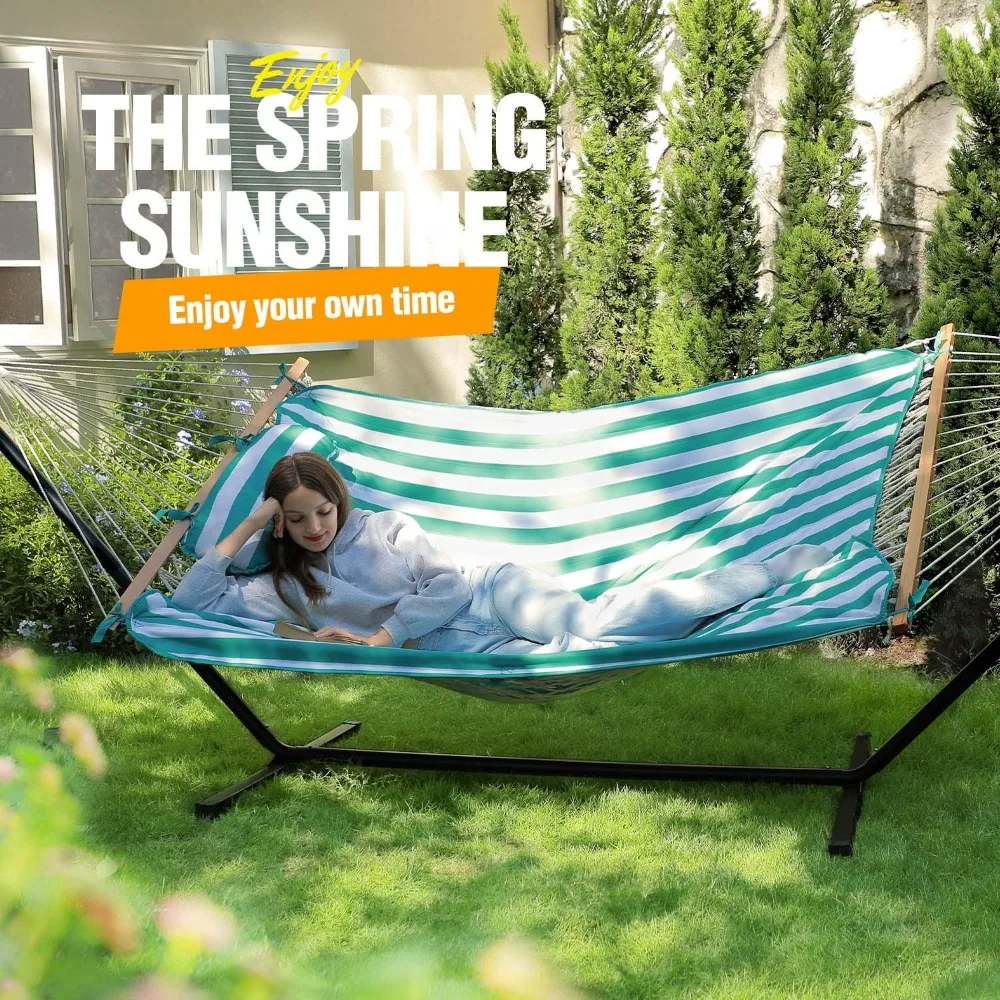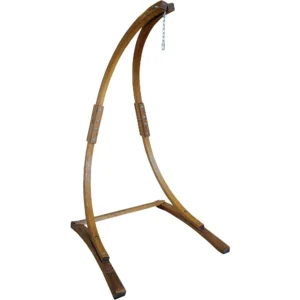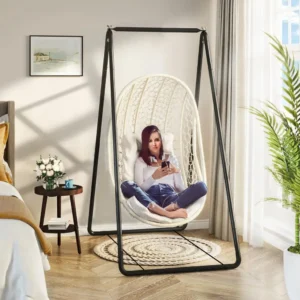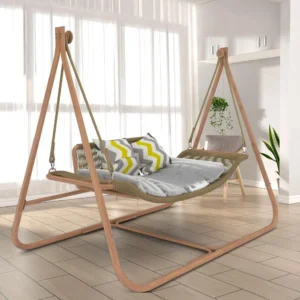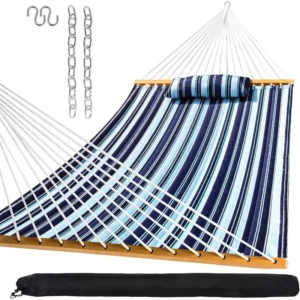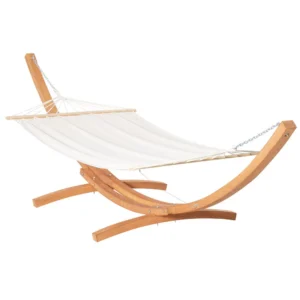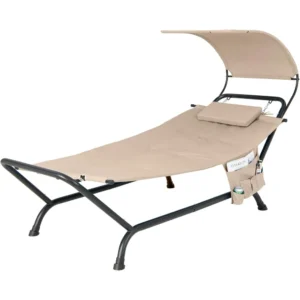1. What Are Spreader Bar Hammocks with Frames?
Spreader bar hammocks feature a distinctive design where wooden or metal bars are attached at each end of the hammock fabric. These bars stretch the material horizontally, creating a flat, open surface that maintains its shape whether occupied or empty. Unlike traditional gathered-end hammocks that envelop you, spreader bar hammocks provide a more structured lounging experience.
The spreader bars themselves typically measure 40-55 inches wide (100-140 cm) and serve a crucial function: they keep the hammock bed taut and prevent it from collapsing around you. This design originated from naval traditions where sailors sought ways to maximize comfort in limited shipboard spaces.
When paired with a dedicated frame, spreader bar hammocks become complete relaxation systems that can be placed anywhere. The frame eliminates the need for trees or existing structures, creating a self-contained unit that combines the classic hammock experience with modern convenience. These complete spreader bar hammock systems represent the evolution of an age-old relaxation method into a versatile, freestanding option suitable for contemporary living spaces.
2. Why Choose a Spreader Bar Hammock with Frame?
Selecting a spreader bar hammock with a dedicated frame offers unique advantages that transform how and where you can enjoy the hammock experience.
Key benefits include:
- Complete Independence: No need for trees, posts, or wall anchors—set up your hammock anywhere with sufficient space.
- Consistent Experience: Enjoy the same comfortable setup every time without worrying about finding suitable hanging points.
- Versatility of Placement: Use your hammock in various settings, from patios and decks to indoor spaces. Safely hanging hammocks indoors becomes simple with a properly designed frame.
- Aesthetic Cohesion: Frames designed specifically for spreader bar hammocks create a visually appealing, complete look that enhances outdoor living spaces.
- Stability and Safety: Purpose-built frames eliminate concerns about anchor point strength and provide stable support.
- Mobility Options: Many hammock and frame combinations can be moved or repositioned as needed, unlike permanent installations.
These complete systems are particularly valuable for renters, those with limited outdoor structures, or anyone who wants the freedom to reposition their relaxation spot according to sun, shade, or social gatherings.
3. Spreader Bar vs. Non-Spreader Bar Hammocks with Frames
| Feature | Spreader Bar Hammocks | Non-Spreader Bar Hammocks |
|---|---|---|
| Body Position | Flat, open surface | Curved, cocoon-like wrap |
| Entry/Exit | Easier, more like sitting on a bench | Requires more technique to enter gracefully |
| Stability | More prone to tipping if weight is unevenly distributed | More forgiving of movement and weight shifts |
| Visual Style | Structured, traditional appearance | Casual, gathered look |
| Typical Use | Sunbathing, reading, casual lounging | Sleeping, enclosed relaxation |
| Weather Resilience | Dries quickly due to open fabric | Retains moisture longer in folds |
| User Experience | Clear visibility of surroundings | Cocooned, private feeling |
Spreader bar hammocks position your body in a flatter orientation, typically at about a 10-15 degree angle to the ground when properly set up. This contrasts with traditional hammocks where your body might rest at 20-30 degrees with more pronounced curves.
The open design of spreader bar hammocks makes them excellent for social settings where visibility and interaction with others matter. They present a more formal, “finished” appearance that many find appealing in designed outdoor spaces.
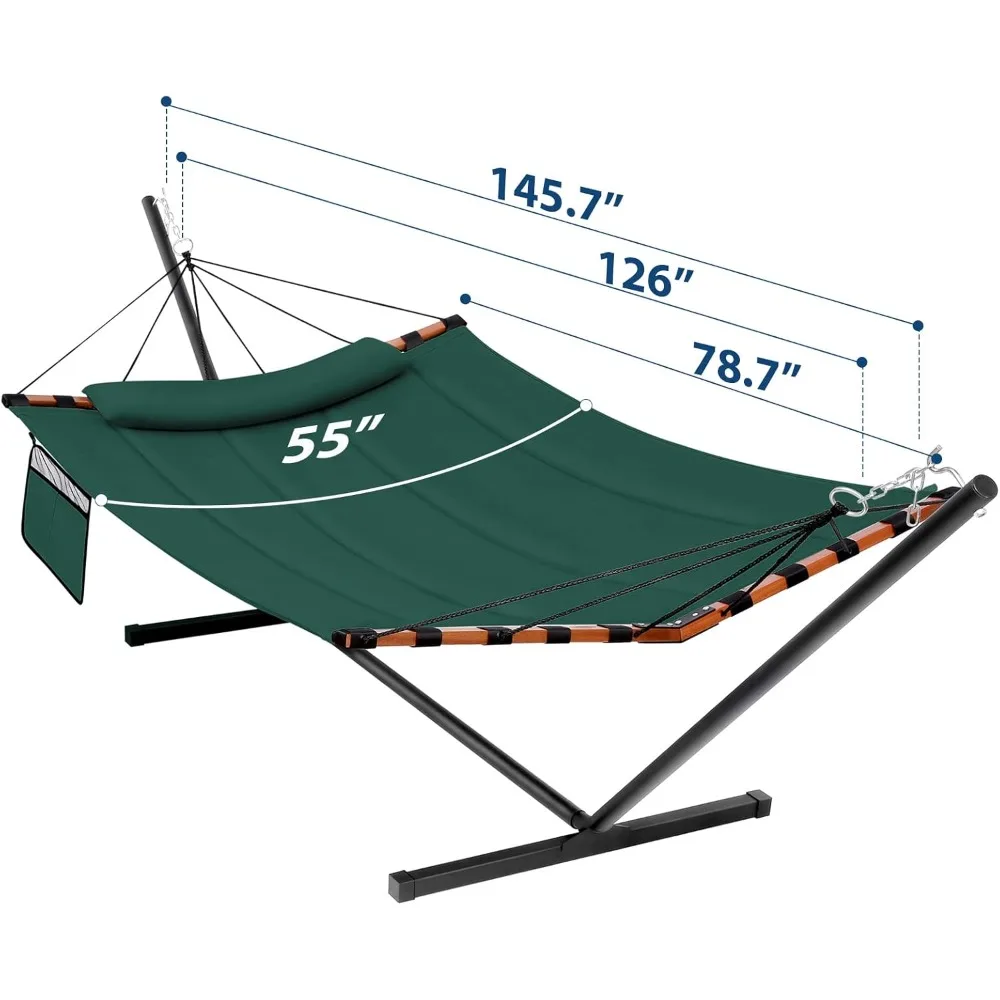
4. Benefits of Spreader Bar Hammocks with Frames
Superior Entry and Exit Experience: The flat, stable surface makes getting in and out of spreader bar hammocks significantly easier than traditional designs, particularly beneficial for those with mobility concerns.
Ideal for Sunbathing: The open, flat surface exposes more of your body to the sun and allows for easier position changes while tanning.
Enhanced Visual Appeal: Spreader bar hammocks have a tailored, finished look that complements designed outdoor spaces and architectural elements.
Quick-Drying Properties: After rain or pool use, the spread fabric dries much faster than bunched hammock material, reducing mildew risk.
Predictable Space Requirements: With a fixed frame, you’ll know exactly how much space your hammock system needs, making placement planning simpler.
Better Scenery Viewing: The flatter position elevates your head naturally, providing better views of your surroundings without extra pillows.
Adaptable Seating Options: Besides traditional lying positions, spreader bar designs allow for comfortable seated positions with feet on the ground.
Consistent Experience: Rope hammocks with spreader bars provide the same comfortable tension every time, unlike hammocks that must be readjusted between uses.
5. Addressing Potential Challenges of Spreader Bar Hammocks
Q: Spreader bar hammocks seem less stable than traditional ones. How can I prevent tipping?
A: Enter from the center rather than the side, and sit down first before swinging your legs up. Keep your weight centered, and consider lower hanging heights for beginners. Many hammock safety guides recommend starting with a height of 16-18 inches from the ground.
Q: I miss the enclosed feeling of traditional hammocks. Any solutions?
A: Add pillows along the sides or choose quilted spreader bar hammocks that provide more cushioning and a sense of enclosure without sacrificing the benefits of spreader bars.
Q: Do spreader bar hammock frames take up too much space?
A: While frames do require dedicated space, many modern designs optimize their footprint. Space-saving models with vertical supports rather than wide bases are available for smaller areas.
Q: Are spreader bar hammock systems too heavy to move?
A: Weight varies significantly by material. Steel frames offer durability but greater weight, while aluminum options provide excellent strength with enhanced portability. Several models feature wheels or disassemble for storage.
6. Hammock Materials: Finding Your Perfect Comfort
Choosing the right hammock material significantly impacts your comfort, durability, and maintenance requirements:
Cotton
– Soft, breathable, and naturally comfortable against skin
– Provides excellent airflow during hot weather
– Requires more protection from elements and proper drying after exposure to moisture
– Typically needs to be brought inside during extended rainy periods
– Offers a traditional, classic appearance
Polyester
– Highly durable with excellent resistance to UV damage
– Quick-drying properties make it ideal for poolside or high-humidity locations
– Maintains color and structural integrity longer than natural fibers
– Less prone to mildew and easier to clean
– Available in vibrant colors that resist fading
Premium Synthetic Materials (Olefin/Sunbrella)
– Superior weather resistance with minimal fading over many seasons
– Exceptional longevity, often lasting 5+ years with proper care
– Resistant to stains, mildew, and moisture damage
– Higher initial investment but better long-term value
– Often feels softer than standard polyester options
Textilene/PVC Coated Mesh
– Ideal for pool areas with chlorine exposure
– Will not absorb water and dries almost instantly
– Extremely durable with minimal maintenance requirements
– Provides moderate give while maintaining shape
– Often found in contemporary design styles
Quilted Fabrics
– Extra padding provides enhanced comfort for longer lounging
– Quilted fabric hammock sets offer both comfort and style
– Double-sided designs often feature seasonal patterns or reversible options
– Heavier and may take longer to dry than single-layer fabrics
– Excellent for cooler weather or users desiring extra cushioning
Understanding whether hammocks can be left outside in various weather conditions largely depends on your material choice. Premium synthetics offer the best all-weather performance, while cotton requires more protection and care.
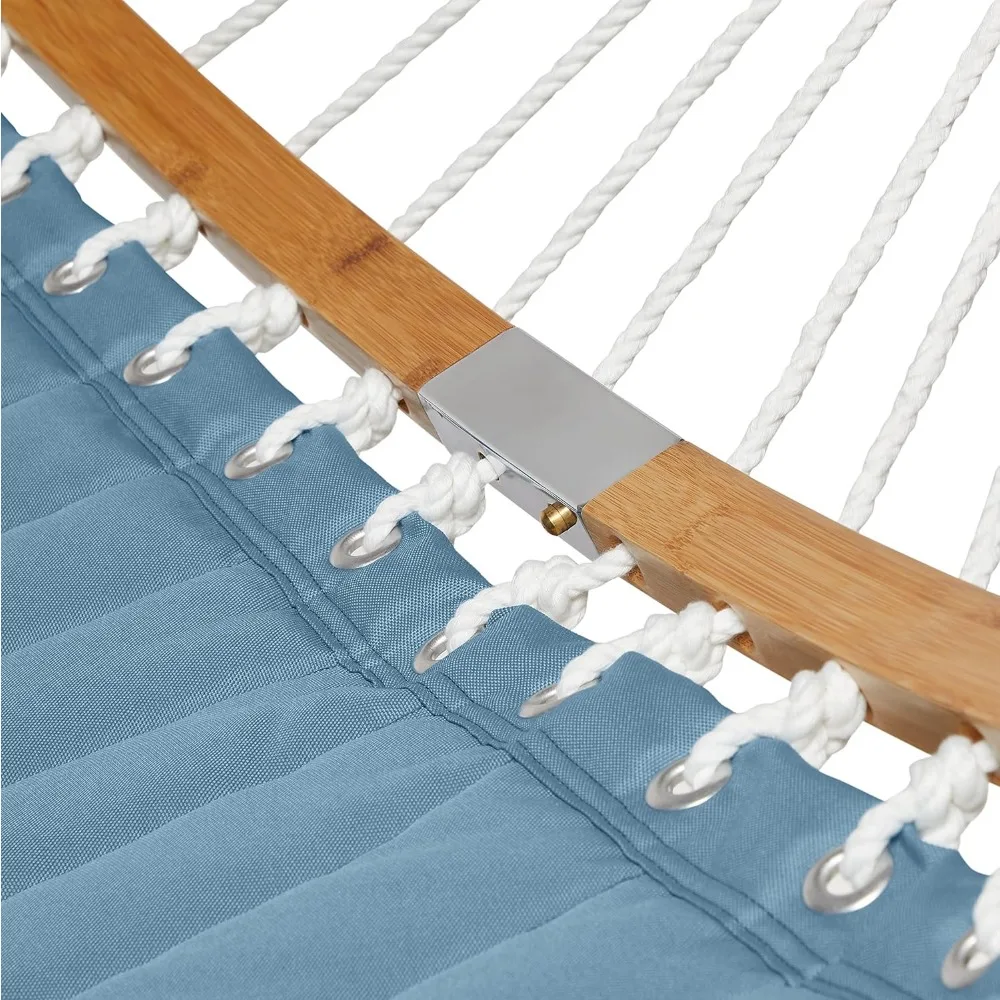
7. Spreader Bar Design and Materials
Spreader bars play a crucial role in both the functionality and aesthetics of your hammock system. Their design and materials influence durability, weight, and overall appearance.
Wooden Spreader Bars
Hardwoods like oak and maple provide excellent strength and natural beauty. These bars typically measure 1-1.5 inches thick and offer a traditional aesthetic that wooden hammock stands complement perfectly. Bamboo options are gaining popularity for their sustainability and distinct look. Wooden bars require occasional treatment with protective oils or sealants to prevent weathering.
Metal Spreader Bars
Aluminum bars offer lightweight strength ideal for portable systems, while powder-coated steel provides maximum durability with rust resistance. Metal spreader bars are often slimmer (0.75-1 inch diameter) than wooden alternatives while providing equal or superior strength. They typically feature plastic or rubber end caps to protect the hammock fabric from wear.
Connection Systems
The interface between spreader bars and hammock bed varies widely, from traditional rope threading through reinforced grommets to specialized quick-connect hardware. Higher-quality hammocks feature reinforced attachment points that distribute weight evenly and prevent fabric tearing.
The length of spreader bars (typically 40-55 inches) directly impacts stability—wider bars generally provide better lateral stability but may make the hammock more challenging to enter for some users.
8. Hammock Size and Weight Capacity Considerations
Selecting the appropriate hammock size ensures optimal comfort and safety for intended users.
Single vs. Double Hammock Sizing:
| Hammock Type | Typical Width | Typical Length | Weight Capacity | Best For |
|---|---|---|---|---|
| Single | 4-5 ft (1.2-1.5 m) | 11-13 ft (3.3-4 m) | 250-300 lbs (113-136 kg) | Individual users, smaller spaces |
| Double | 5-6 ft (1.5-1.8 m) | 13-15 ft (4-4.6 m) | 400-500 lbs (181-227 kg) | Couples, families, larger individuals |
When determining the right hammock size, consider not just the number of users but also your typical usage patterns. Even single users may prefer a double hammock for extra lounging space or to accommodate occasional guests.
Weight capacity requirements should include a safety margin beyond the anticipated load. For example, if you weigh 180 pounds, a hammock rated for at least 250 pounds provides appropriate security. This buffer accommodates dynamic weight shifts and ensures long-term structural integrity.
Remember that frame compatibility depends on hammock length. Ensure your frame is designed to accommodate your specific hammock’s dimensions, with proper weight capacity guidelines matched between both components. A mismatch in either dimension or weight rating can compromise both comfort and safety.
9. Understanding Hammock Frame Types and Materials
Hammock frames come in diverse materials and designs, each offering unique benefits for different situations.
Steel Frames
Steel frames provide superior strength and stability, typically supporting 450-600 pounds. They feature weather-resistant powder coating or galvanized finishes to prevent rust. While heavier (often 30-50 pounds), their solidity makes them excellent for permanent setups. The weight becomes an advantage in windy conditions, providing greater stability than lighter alternatives.
Wooden Frames
Wooden frames, often crafted from pressure-treated pine, cypress, or exotic hardwoods, offer unmatched aesthetic appeal. Their natural look integrates beautifully with garden landscapes. Wooden arc stand hammock sets provide both visual elegance and functional stability. Though requiring more maintenance (annual sealing or staining), quality wooden frames can last decades with proper care.
Aluminum Frames
Aluminum frames balance strength and portability with weights typically between 15-30 pounds. Resistant to corrosion, they’re ideal for coastal environments. Their lightweight nature makes them perfect for repositioning around your yard or taking on trips.
Design Variations
- Arc/Curved Designs: These elegant frames distribute weight through curved supports that provide excellent stability while creating a striking visual statement.
- Straight/Linear Designs: More space-efficient, these frames use a minimalist approach with straight supports and a smaller footprint.
- Space-Saving Options: Some frames feature vertical supports instead of wide bases, reducing the overall footprint while maintaining stability.
- Portable Systems: Collapsible frames that disassemble into smaller components for transport or storage, often featuring carrying cases or built-in wheels.
Each frame type offers different assembly requirements, portability features, and visual impact in your outdoor space.
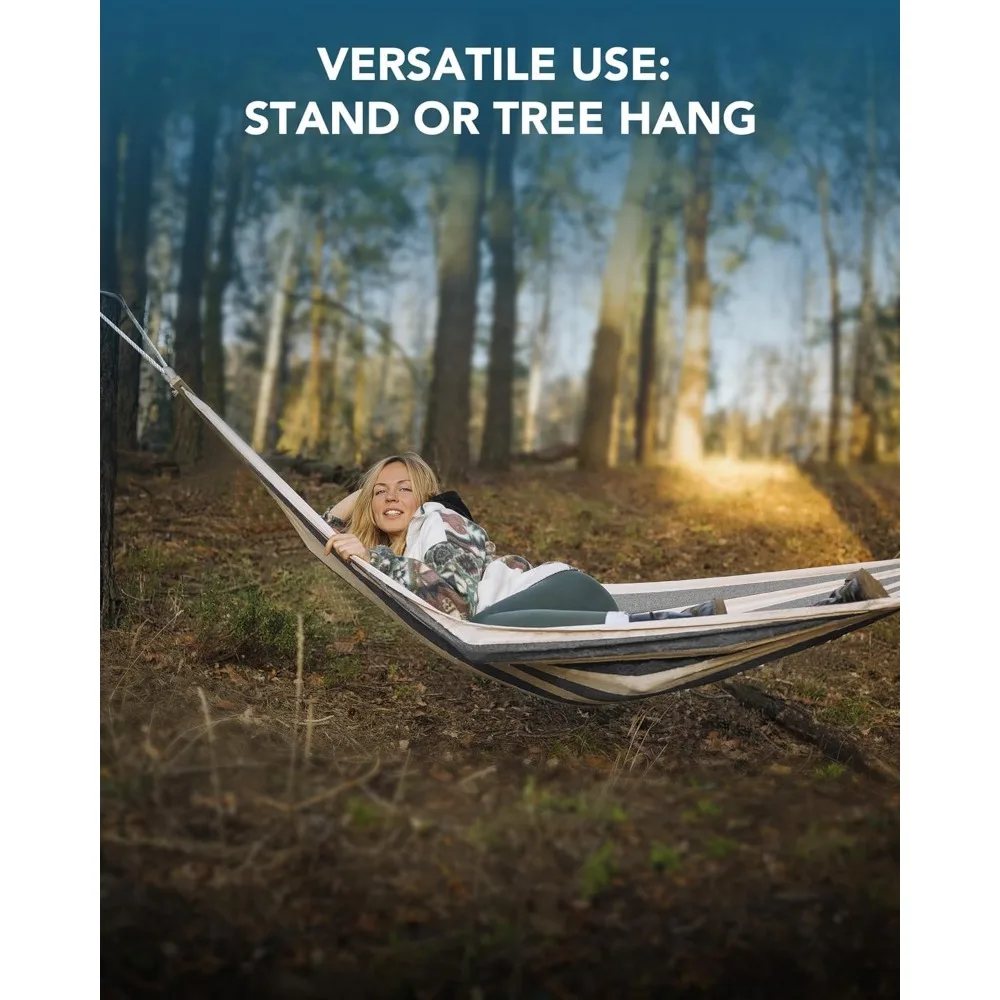
10. Key Frame Features for Optimal Experience
When selecting a hammock frame, certain features significantly impact your overall experience:
Weight Capacity Matching: Ensure your frame’s weight rating exceeds your hammock’s capacity. For example, heavy-duty hammock sets designed for multiple users should have frames rated for 450+ pounds.
Critical Dimensions: Beyond length compatibility (typically 1-2 feet longer than your hammock), consider the frame’s height (usually 4-5 feet) and base width (typically 4-6 feet) to ensure stability and comfort.
Quality Indicators: Look for thick-walled tubing (at least 1.5-2 inches in diameter for steel), reinforced joints, and weather-resistant finishes. Wooden frames should feature marine-grade hardware and proper sealing.
Assembly Complexity: Most frames require 20-40 minutes for initial assembly. Quality models feature tool-free adjustment systems and clear instructions with minimal required tools.
Stability Enhancers: Wide-stance legs, cross-bracing, ground stakes for outdoor use, and non-slip feet improve stability on various surfaces.
Portability Features: Collapsible designs, quick-disconnect fittings, carrying cases, and built-in wheels facilitate transportation and storage when not in use.
Weather Resistance: Powder-coated steel, galvanized hardware, marine-grade treatments, and UV-resistant components extend outdoor longevity and reduce maintenance requirements.
11. Ensuring Perfect Hammock and Frame Compatibility
Achieving proper compatibility between your spreader bar hammock and frame requires attention to specific measurements and relationships:
Length Relationship Calculation
The optimal frame should be approximately 24 inches (60 cm) longer than your hammock’s total length. For example, a hammock measuring 13 feet (4 m) in total length works best with a 15-foot (4.6 m) frame.
Measuring Total Hammock Length Correctly
To determine total hammock length, measure from the end of one suspension rope or chain to the other while the hammock is laid flat and slightly tensioned. Include the entire length of rope or chain that comes with the hammock, not just the fabric portion.
Optimal Hanging Height Adjustment
Most spreader bar hammocks perform best when hung 18-24 inches (45-60 cm) from the ground at their lowest point when occupied. This height provides the ideal balance of comfort and ease of entry/exit. Many frames feature multiple attachment points or adjustable hooks to fine-tune this height.
Weight Capacity Synchronization
Always match or exceed the hammock’s weight capacity with your frame. When manufacturers provide different ratings, always defer to the lower number as your maximum safe capacity.
Following proper hammock installation requirements ensures both comfort and safety. Remember that most spreader bar hammocks require approximately a 20-30 degree angle from horizontal when properly installed, which the frame should be designed to accommodate.
12. Optimizing Comfort in Your Spreader Bar Hammock
Despite their flatter design compared to traditional hammocks, spreader bar hammocks can provide exceptional comfort with these optimization strategies:
Finding Your Perfect Sag
While spreader bars create a flatter surface, they still allow for some degree of beneficial curvature. Adjust your hammock to achieve a slight 20-30 degree sag from horizontal for the optimal balance of support and comfort. This gentle curve helps align your body naturally without excessive pressure points.
Strategic Pillow Placement
Position a small cushion or rolled towel under your neck for cervical support. For those who prefer side-lying positions, placing a thin pillow between your knees can improve spinal alignment. Some users benefit from lumbar support positioned under the small of the back.
Body Positioning Techniques
For maximum comfort, lie at a slight diagonal across the hammock rather than perfectly straight. This position creates a flatter lying surface and distributes your weight more evenly across the fabric. Experimenting with different positions—from fully reclined to partially seated with feet touching the ground—can help you discover your perfect relaxation pose.
Seasonal Comfort Adjustments
During warmer months, a light breathable blanket beneath you can absorb perspiration while providing cushioning. In cooler weather, layering with throws or investing in hammock sets with canopies provides both warmth and protection from elements.
Common Discomfort Solutions
If you experience pressure under your knees, try placing a small cushion there or adjusting your diagonal position. For those who find the rope or fabric pattern creates pressure points, adding a thin mattress topper or blanket underneath creates a smoother surface.
13. Ensuring Stability and Safety
Maximizing both safety and enjoyment of your spreader bar hammock requires attention to proper techniques:
Safe Entry and Exit Method
1. Stand beside the center of the hammock (not the end)
2. Place one hand on each side of the hammock for balance
3. Sit down in the middle of the hammock as you would on a bench
4. Slowly swing your legs up while maintaining centered weight
5. To exit, reverse the process—swing legs out first, then stand up from seated position
Weight Distribution Principles
Keep your center of gravity aligned with the hammock’s midline. Avoid sudden movements or shifting your entire weight to one side, which can cause tipping. For two-person use, enter one at a time and position yourselves for balanced weight distribution.
Surface Considerations
Place frames on level ground, removing rocks or debris that could cause instability. On decking, ensure weight is distributed across multiple support beams rather than concentrated on a single section. For uneven ground, use leveling blocks under frame legs to create stability.
Weather Precautions
In windy conditions, lower the hanging height to reduce swaying. Consider temporary anchoring for extremely windy days. Remove or secure your hammock before severe weather events to prevent damage.
Regular Safety Checks
Inspect all hardware, connections, and fabric monthly for signs of wear or loosening. Pay special attention to the interface between spreader bars and fabric, as this experiences the most stress. Tighten any loose bolts or screws before each use season.
Child Safety Measures
Always supervise children using spreader bar hammocks. Teach proper entry/exit techniques and establish clear rules about capacity and appropriate use. Consider lower hanging heights when children will be primary users.
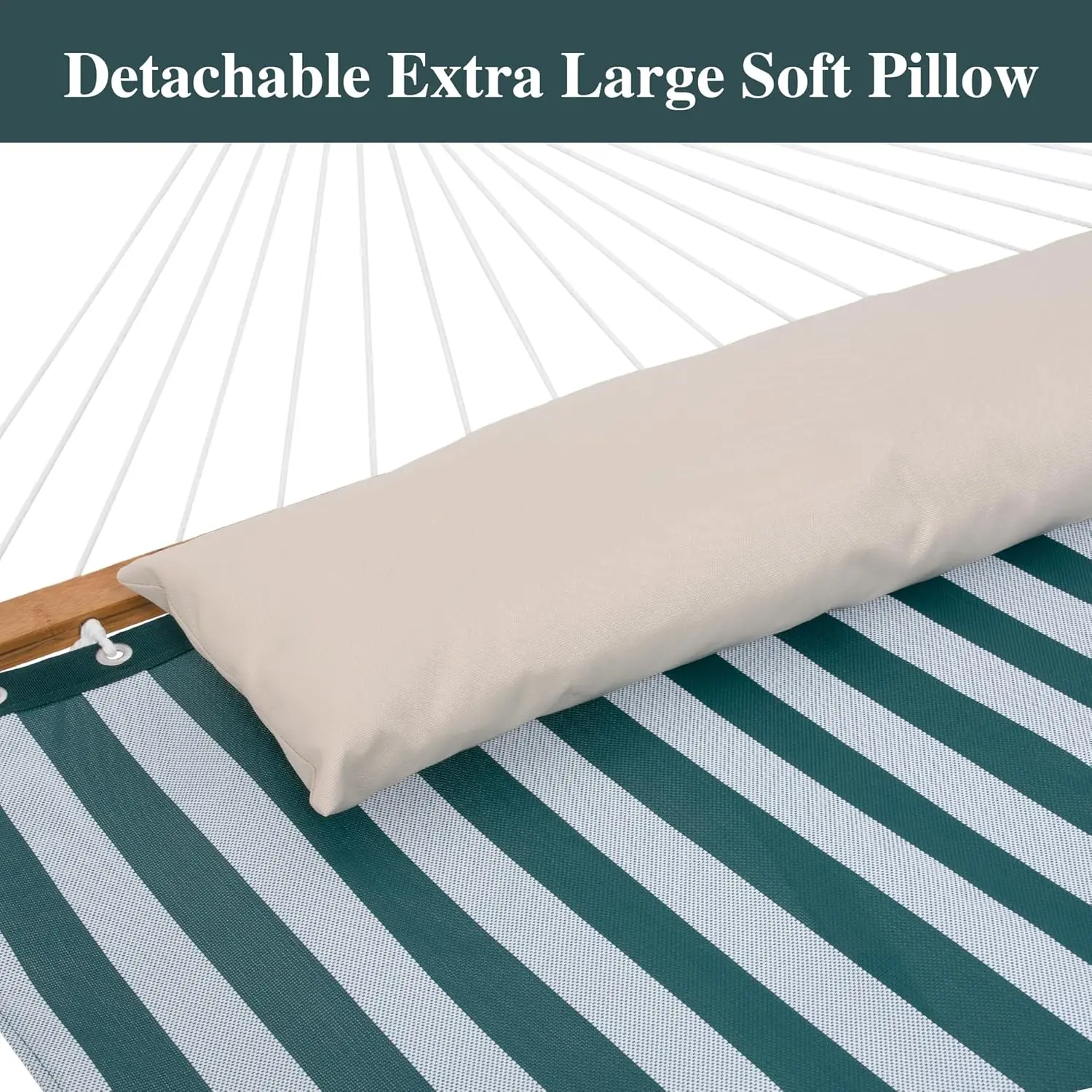
14. Ideal Settings for Your Spreader Bar Hammock with Frame
Your spreader bar hammock system can enhance various environments when properly positioned:
Patio and Deck Placements
Position your hammock to complement existing outdoor furniture arrangements rather than obstructing traffic flow. On wooden decks, align the frame perpendicular to the decking boards to distribute weight across multiple joists. Allow at least 2 feet of clearance on all sides for easy access and comfortable entry/exit.
Poolside Setups
Choose synthetic materials like Textilene or solution-dyed acrylics that resist chlorine and moisture damage. Position at least 3-4 feet from the pool edge for safety while remaining close enough for convenient transitions between swimming and relaxing. Finding optimal hammock locations around water features requires balancing proximity with safety.
Indoor Relaxation Spots
Living rooms, sunrooms, and bedrooms can accommodate hammock frames with appropriate planning. Ensure adequate clearance from walls and furniture (minimum 2 feet on all sides). Consider the visual weight of different frame materials—wooden frames often integrate better with interior décor, while metal frames may suit modern interior designs.
Lawn Placements
Rotate positions periodically to prevent lawn damage from constant shade. On softer ground, use flat pavers under each foot to prevent sinking and maintain stability. For sloped areas, position the frame perpendicular to the slope for maximum stability or use leveling blocks.
Temporary Event Setups
For gatherings or special occasions, create inviting hammock havens by positioning multiple hammocks in conversational clusters. Consider privacy, view orientation, and sun exposure when arranging temporary installations.
Seasonal Considerations
In summer, seek partial shade locations that offer sun protection during peak hours while allowing morning or late afternoon sunshine. For winter use in temperate climates, position in full sun areas protected from prevailing winds.
15. Assembly, Setup, and Installation
Setting up your spreader bar hammock with frame typically requires minimal tools and time when following these guidelines:
Typical Assembly Requirements
Most frames require a wrench or socket set for initial assembly, though many newer models feature tool-free designs. Having an adjustable wrench, socket set, and possibly a rubber mallet on hand covers most assembly needs. Working with a helper significantly simplifies the process.
General Assembly Sequence
1. Lay out all components and verify all parts are included
2. Assemble the base structure first, ensuring all connections are aligned properly
3. Attach vertical supports or curved components
4. Install any cross-bracing or stabilizing elements
5. Finally, add hammock attachment points or hooks
Proper Hammock Attachment
Ensure the spreader bars are perfectly parallel before attaching to the frame. Most systems use chains, S-hooks, or carabiners to connect the hammock to the frame. Verify that all connection points are fully closed and secure before use.
Tension Adjustment
Proper tension creates the ideal 20-30 degree angle in your hammock. If your frame has multiple attachment points, start with the middle or recommended setting, then adjust after testing. The hammock should have a gentle curve when unoccupied but not excessive sagging.
Quick-setup hammock sets often feature intuitive designs that simplify this process with color-coded components or numbered assembly steps. For frames that will be moved frequently, consider marking components for easier reassembly.
Common Assembly Challenges
If parts don’t align properly, avoid forcing connections. Instead, loosen adjacent connections slightly, align the problematic joint, then gradually tighten all connections. For wooden frames, pre-drill holes that show signs of splitting to prevent damage during screw insertion.
16. Care and Maintenance for Longevity
Proper maintenance dramatically extends the life of your spreader bar hammock system:
Fabric Care by Material Type
Cotton: Hand wash with mild soap and cool water, avoiding bleach or harsh detergents. Allow to air dry completely before storage. Apply fabric protectant designed for outdoor cotton annually.
Polyester/Synthetic Fabrics: Clean with mild soap and water, using soft brushes for stubborn stains. These materials can typically be left out longer than cotton but benefit from periodic cleaning to remove pollen, sap, and environmental debris.
Textilene/Mesh Materials: Hose off regularly and clean with diluted dish soap for stubborn stains. These materials require minimal maintenance and can generally remain outdoors through most weather conditions.
Frame Maintenance
Steel Frames: Inspect for rust quarterly and touch up any paint chips promptly with matching outdoor paint. Apply automotive wax to powder-coated surfaces annually to enhance weather resistance.
Wooden Frames: Apply wood preservative or sealant annually, focusing on joints and areas exposed to direct weather. Tighten all hardware at the beginning of each season, as wood naturally expands and contracts.
Hardware Components: Replace any rusted or damaged hardware immediately with stainless steel alternatives for longer life. Apply silicone lubricant to chains or moving parts annually.
Off-Season Storage
When storing for extended periods, ensure all components are thoroughly dry. Store fabric hammock bodies in breathable bags rather than plastic containers to prevent moisture buildup. Cover frames or bring them indoors when possible during extreme weather seasons.
Finding the perfect hammock placement impacts maintenance needs—hammocks placed under trees require more frequent cleaning, while those in full sun may experience faster fabric fading despite better drying after rain.
17. How to Select the Perfect Spreader Bar Hammock with Frame
Finding your ideal hammock system involves systematic evaluation of your specific needs:
Step 1: Assess Your Requirements
Begin by considering where you’ll place your hammock system and how it will be used. Measure your available space carefully, allowing for the frame footprint plus 2-3 feet of clearance on all sides. Consider whether your location is primarily sunny or shady, as this affects both comfort and material selection.
Determine the primary users and their combined weight to establish your capacity requirements. Single hammocks typically support 250-300 pounds, while doubles handle 400-500 pounds. If you plan to relocate your hammock frequently, prioritize portable hammocks and stands that offer lightweight materials and collapsible designs.
Step 2: Prioritize Key Features
For highly exposed outdoor locations, prioritize weather resistance with synthetic fabrics and powder-coated or galvanized steel frames. If aesthetic integration with landscape design is important, wooden frames or those with architectural elements may justify additional investment.
Consider assembly complexity based on your comfort with tools and available assistance. Some systems offer tool-free setup while others require more involved assembly but may provide greater stability. Evaluate safety features like non-tip designs and stable bases, particularly important for households with children or pets.
Step 3: Navigate Product Information Effectively
When reviewing product specifications, focus on weight capacity, dimensions, and material quality rather than marketing descriptions. For hammock fabric, higher thread counts or denier ratings generally indicate better durability. For frames, look for wall thickness of tubing (thicker is stronger) and quality of welds or joinery.
When evaluating reviews, look for comments about long-term use rather than initial impressions. The most helpful reviews often mention specific use cases similar to your intended application. Understanding the differences between indoor and outdoor hammocks helps match product specifications to your specific needs.
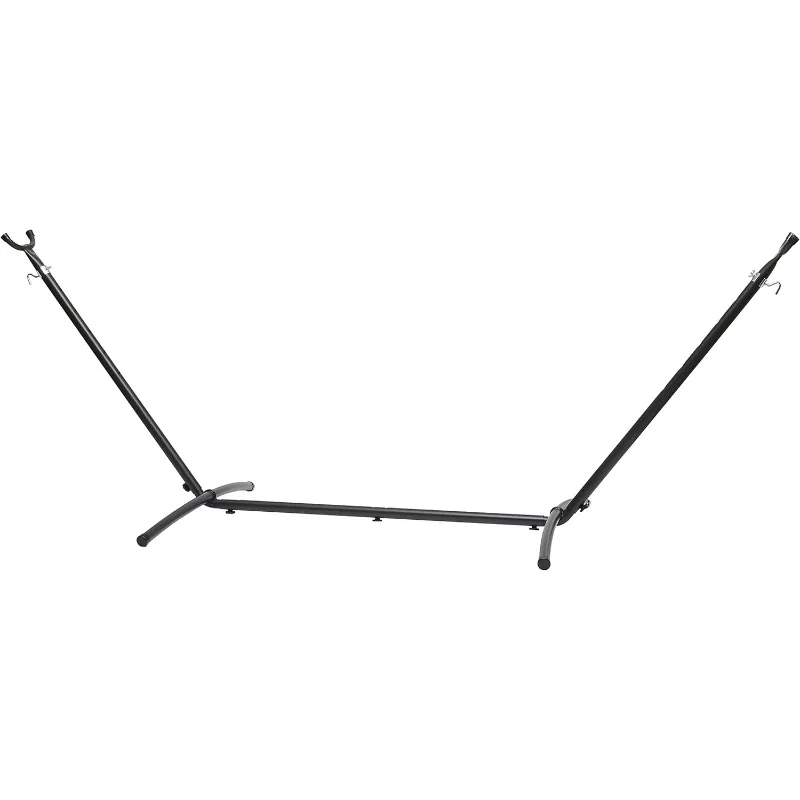
18. Frequently Asked Questions About Spreader Bar Hammocks with Frames
Can I leave my hammock setup outside year-round?
Weather resistance varies significantly by material. Synthetic fabrics like Sunbrella or Textilene can withstand extended outdoor exposure, while cotton requires protection from prolonged moisture. Even with weather-resistant materials, removing the hammock portion during extreme weather or winter months extends its lifespan considerably. Frames generally tolerate outdoor conditions better than hammock fabrics.
How do I prevent my spreader bar hammock from tipping?
Enter from the center rather than the side, keeping your weight centered as you sit down before swinging your legs up. Choose frames with wider bases or lower hanging heights for improved stability. Some users find that beginning with a gentler sag (less tension) provides more forgiveness for movement.
What is the average lifespan of a quality hammock system?
With proper care, premium spreader bar hammocks typically last 5-7 years of regular seasonal use. Frames often outlast hammocks, with steel frames lasting 10+ years and quality wooden frames potentially lasting 15-20 years with proper maintenance. Replacing only the hammock portion when needed is more economical than replacing the entire system.
Are spreader bar hammocks comfortable for napping or sleeping?
Many users find spreader bar hammocks excellent for napping, though they provide a different experience than traditional hammocks. Their flatter surface accommodates a wider range of sleeping positions, including side-sleeping with proper support. For extended sleeping, adding a thin pad can enhance comfort by softening the feel of rope hammocks.
How much space do I need for a hammock with frame?
Typical spreader bar hammock frames require a footprint of about 14-15 feet in length and 4-5 feet in width, plus 2-3 feet of clearance on all sides for safe entry and exit. Compact models designed for smaller spaces may reduce these dimensions slightly but generally still require at least 12 feet of length. Indoor hammock placement may require careful measurement to ensure adequate space.
Are wooden frames better than metal frames?
Neither is universally “better”—each offers distinct advantages. Wooden frames provide superior aesthetic appeal and natural integration with outdoor spaces but require more maintenance. Metal frames offer greater durability with less upkeep and often support higher weight capacities at lower price points. Your specific priorities regarding appearance, maintenance willingness, and budget should guide this decision.
19. Enhancing Your Hammock Experience with Accessories
The right accessories can transform your spreader bar hammock from merely comfortable to truly exceptional:
Weather Protection Options
Attachable canopies provide shade without relocating your entire setup. Look for models with adjustable angles to track the sun throughout the day. Waterproof hammock covers extend outdoor seasons by protecting against light rain and morning dew.
Comfort Enhancers
Specially designed hammock pillows with straps prevent slipping and enhance neck support. Quilted pads create a softer surface, especially valuable for rope hammocks. Some cushioning systems feature removable, washable covers for easy maintenance.
Convenience Add-Ons
Side tables that attach directly to hammock frames keep essentials within reach without standing up. Book or phone holders suspend reading materials at optimal viewing positions. Cup holders prevent spills while allowing full relaxation.
Ambiance Creators
Weather-resistant LED string lights that attach to frames create evening ambiance. Bluetooth speakers designed for outdoor use bring music to your relaxation space. Some A-frame stand hammock sets feature integrated lighting options.
Storage Solutions
Under-hammock storage nets suspend personal items within easy reach while maximizing space. Side pockets attach to hammock edges for keeping sunscreen, books, or electronics accessible. Storage bags that attach to frame components keep larger items off the ground.
Dark Wood Hammock Sets, Porch Swing Chair Sets
$653.82 Select options This product has multiple variants. The options may be chosen on the product pageA-Frame Stand Hammock Sets, Swinging Hammock Chair Sets
$154.62 Select options This product has multiple variants. The options may be chosen on the product pageLight Wood Hammock Sets, Swinging Hammock Chair Sets
$1,359.35 Select options This product has multiple variants. The options may be chosen on the product pageClassic Wooden Stand Hammock Sets, Heavy Duty Hammock Sets
$1,061.68 Select options This product has multiple variants. The options may be chosen on the product pageHammock Sets with Canopy, Heavy Duty Hammock Sets
$286.31 Select options This product has multiple variants. The options may be chosen on the product page
Seasonal Accessories
Hammock-specific blankets designed to stay in place despite movement extend use into cooler evenings. Insect netting systems that fully enclose the hammock area protect against mosquitoes and other pests during peak seasons.
20. Creative Uses Beyond Traditional Lounging
Your spreader bar hammock system can serve multiple purposes beyond basic relaxation:
Reading Retreats
Create the perfect reading environment by positioning your hammock to capture optimal natural light throughout the day. Add a small side table for beverages and additional reading materials. A cushioned headrest adjusted to your preferred reading angle prevents neck strain during extended sessions.
Outdoor Home Office
Transform your hammock into a productive workspace by adding a lap desk designed for outdoor use. Position the frame where WiFi signals remain strong while minimizing screen glare. Schedule video calls from your hammock to bring a unique perspective to remote work.
Meditation and Wellness Space
The gentle rocking motion of hammocks naturally induces theta brain waves associated with deep relaxation and meditation. Add aromatherapy elements nearby to enhance the sensory experience. Some practitioners find that two-person hammocks provide additional space for guided meditation postures.
Social Seating Arrangements
Position multiple hammocks in conversational formations for unique social gatherings. For parties, create a hammock lounge zone where guests can relax away from more active areas. The novelty of hammock seating often becomes a natural conversation starter.
Overnight Sleeping Alternative
For occasional guests or summer sleeping, spreader bar hammocks can serve as comfortable beds. Add a thin mattress topper for additional cushioning and insulation. Position a small table nearby for essentials like water, reading light, and personal items.
Seasonal Display Platform
Decorate your hammock and frame for holidays or special occasions, incorporating lights, fabrics, or themed elements. During flower-growing seasons, position potted plants around your hammock frame to create an immersive garden retreat.
With proper selection, setup, and maintenance, your spreader bar hammock with frame becomes more than just furniture—it transforms into a versatile lifestyle enhancement that adapts to your changing needs throughout the seasons.

